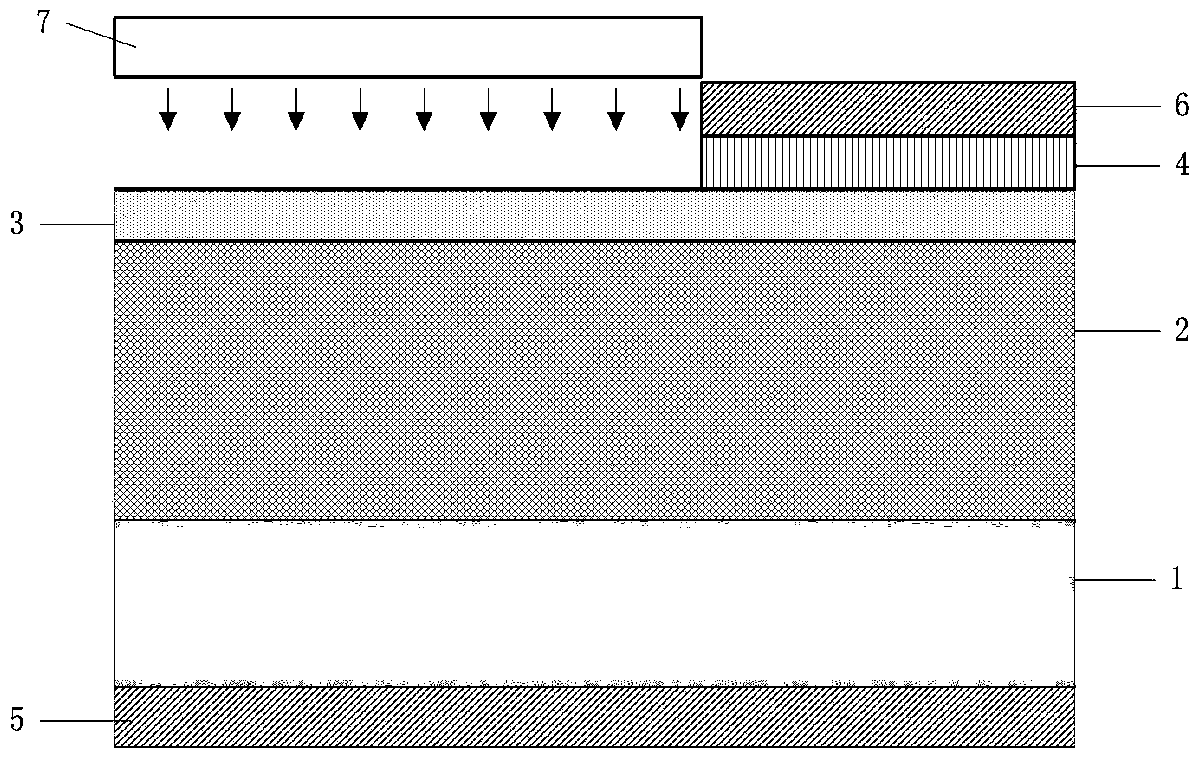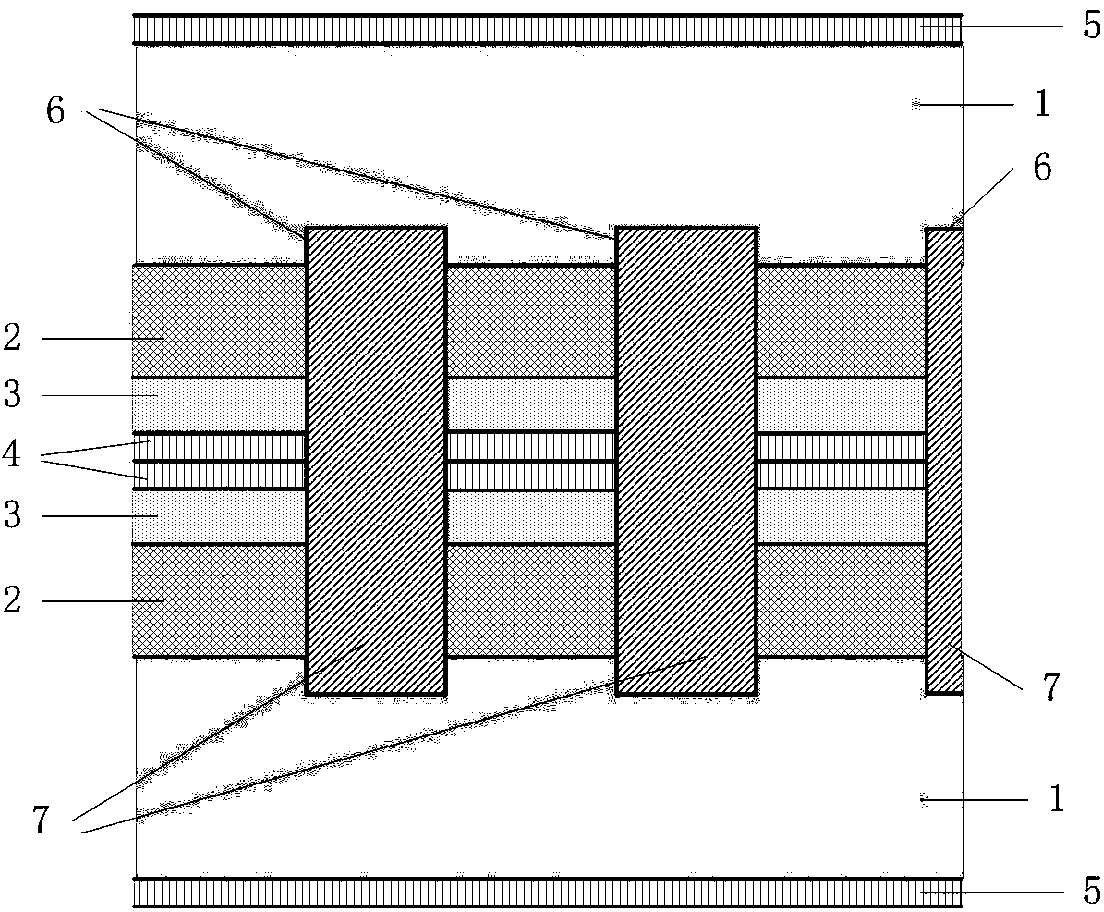Parallel type PIN type beta irradiation battery and preparing method thereof
A parallel, battery technology, applied in the field of microelectronics, can solve the problems of large energy loss of incident particles and low energy conversion efficiency in nuclear batteries, and achieve the effects of improving energy collection rate, reducing damage, and increasing output current.
- Summary
- Abstract
- Description
- Claims
- Application Information
AI Technical Summary
Problems solved by technology
Method used
Image
Examples
Embodiment 1
[0039] Embodiment 1, preparation β radiation source is Ni 63 , a parallel-connected PIN-type β-irradiated cell with two trenches.
[0040] Step 1: Make the lower PIN knot.
[0041] (1) Clean the 4H-SiC sample to remove surface pollutants, such as image 3 (a) shown.
[0042] (1.1) Set the doping concentration to lx10 18 cm -3 Highly doped n-type 4H-SiC substrate sample in NH 4 OH+H 2 o 2 Soak the sample in the reagent for 10 minutes, take it out and dry it to remove the organic residue on the surface of the sample;
[0043] (1.2) Use HCl+H to remove the 4H-SiC sample after removing the surface organic residue 2 o 2 Soak the sample in the reagent for 10 minutes, take it out and dry it to remove ionic pollutants.
[0044] (2) Epitaxial growth of N-type low-doped epitaxial layer, such as image 3 (b) shown.
[0045] A nitrogen-doped N-type doped epitaxial layer is epitaxially grown on the cleaned SiC sample by chemical vapor deposition CVD. The process conditions are...
Embodiment 2
[0063] Embodiment 2, preparation β radiation source is Ni 63 , a parallel-connected PIN-type β-irradiated cell with six trenches.
[0064] Step 1: Make the lower PIN knot.
[0065] 1) Clean the 4H-SiC sample to remove surface contaminants, such as image 3 (a).
[0066] This step is the same as step (1) of Example 1.
[0067] 2) Epitaxial growth of N-type low-doped epitaxial layer, such as image 3 (b).
[0068] A nitrogen-doped N-type doped epitaxial layer is epitaxially grown on the cleaned SiC sample by chemical vapor deposition CVD. The process conditions are: epitaxy temperature is 1570°C, pressure is 100mbar, reaction gas is silane and propane, carrier gas is pure hydrogen, magazine source is liquid nitrogen, and the concentration of nitrogen doping is 1.5x10 15 cm -3 , the growth of an N-type low-doped epitaxial layer with a thickness of 8 μm.
[0069] 3) Epitaxial growth of P-type highly doped epitaxial layer, such as image 3 (c) shown.
[0070] On the grown...
Embodiment 3
[0083] Embodiment 3, preparation β radiation source is Pm 147 , a parallel-connected PIN-type beta-irradiated cell with 12 trenches.
[0084] Step A: Make the upper PIN knot.
[0085] (A1) Clean the 4H-SiC sample to remove surface contaminants, such as image 3 (a).
[0086]This step is the same as step (1) of Example 1.
[0087] (A2) Epitaxially grow a nitrogen-doped N-type low-doped epitaxial layer on the cleaned SiC sample by chemical vapor deposition CVD. The process conditions are as follows: the epitaxy temperature is 1570°C, the pressure is 100mbar, the reaction gas is silane and propane, the carrier gas is pure hydrogen, and the magazine source is liquid nitrogen. A nitrogen doping concentration of 3x10 15 cm -3 , the N-type low-doped epitaxial layer with a thickness of 10 μm such as image 3 (b).
[0088] (A3) A P-type highly doped epitaxial layer doped with aluminum ions is epitaxially grown on the grown N-type low-doped epitaxial layer by chemical vapor depo...
PUM
 Login to View More
Login to View More Abstract
Description
Claims
Application Information
 Login to View More
Login to View More - R&D
- Intellectual Property
- Life Sciences
- Materials
- Tech Scout
- Unparalleled Data Quality
- Higher Quality Content
- 60% Fewer Hallucinations
Browse by: Latest US Patents, China's latest patents, Technical Efficacy Thesaurus, Application Domain, Technology Topic, Popular Technical Reports.
© 2025 PatSnap. All rights reserved.Legal|Privacy policy|Modern Slavery Act Transparency Statement|Sitemap|About US| Contact US: help@patsnap.com



